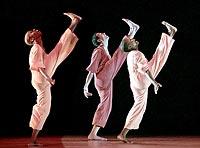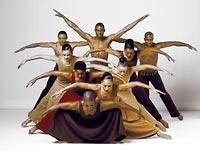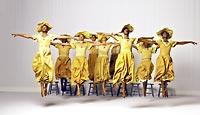Alvin Ailey's masterpiece "Revelations" continues to inspire dancers and audiences

When the Alvin Ailey American Dance Theater comes to town it creates a different kind of buzz. Friends will ask if you are going to see Ailey in a way they don't about other dance troupes. People feel connected, even invested in it. There's almost a kind of reverence in the question: "Are you going to see Alvin Ailey?"
Ailey is not only a classic part of modern dance but also of African-American history and identity. The company's signature work, the 1960 "Revelations," with its images of church-going women in floppy hats rockin' their souls, or prancing with a big white umbrella, is a cultural icon, performed in nearly every Ailey program. And with good reason: It's the foundation of the company.
Ailey dancers reach their audiences in a way that few others do. At Ailey the norm is for dancers to give everything they've got, to be generous not only with their big athleticism and technique, but also with their humanity and their vulnerability.
The risk-taking and expansive technique comes from the dancers' constant exposure to new dances. But the attention paid to the spirit and emotion underlying the physical surely comes from continually performing "Revelations."
Some companies with such an overshadowing masterpiece might shy away from it, in favor of the new. Ailey himself is said to have been frustrated by the fact that he never produced another dance of its magnitude. But he always came back to "Revelations," because he knew both the dancers and the audience loved it.
Expanding the legacy
Other companies with an unrepeatable masterpiece might make the mistake of depending on that work alone. But the Ailey company uses this ballet as a source of strength, inspiration and outreach while at the same time emphasizing new choreography.
Under the direction of Judith Jamison since Alvin Ailey's death in 1989, the company has also expanded its school and outreach programs. In 2005 Ailey completed a $54 million dollar building in downtown Manhattan, with space for its second company and school. All of this took root out of "Revelations."
In addition to being a spiritual inspiration, "Revelations" is, in a way, a container of physical dance technique, serving as barre exercises do in the ballet tradition. Based on classic modern-dance moves out of Martha Graham, Lester Horton and the jazz of Jack Cole, it provides a continued workout in these movement styles.
It is possible to imagine an Ailey company 50 years from now, performing new types of experimental choreography that no one has yet dreamed up, but still comfortable with the vocabulary of classic modern dance, still driven by the emphasis on the dancers' humanity and spirituality, because they are still dancing the repository of all these qualities, "Revelations."
Blood memories
The ballet itself was inspired by what Alvin Ailey called his "blood memories" of growing up in Texas and of the Sunday services in tiny churches with their outdoor baptisms. It is built on the spirituals of that time and includes private moments like "I Wanna Be Ready" to big communal celebrations, like "Wade in the Water" and "Rocka My Soul in the Bosom of Abraham." Structured like a building wave of energy, its power lies in its music, its dance, its sense of theatrics, and its base in the history of the black people.
" 'Revelations' is our meditation," Ailey rehearsal director Ronni Favors told The Seattle Times in 2003. In phone calls last week with Favors and with Ailey dancer Clifton Brown, the words humanity, generosity, honesty and truth kept coming up. It was as if the words of the spirituals that "Revelations" is based on had infused the culture of the dance company itself.
"Any artist is always teetering on the brink," Favors said. "You have to go to the precipice, as Ms. Jamison likes to say. When it comes to really being able to express oneself and to get to a place where an audience member can be touched by the depth of the emotion that's coming across the stage, it's a little bit of a risky proposition for the performer. You have to make yourself vulnerable. You have to open up a lot and take those kinds of risks so they can be felt across the footlights."
Going to the edge
As rehearsal director, Favors' job is to make sure the steps and style stay true to the intention of the various choreographers whose work is being performed. However, she rarely has to push the dancers.
"There's an expectation that an Ailey dancer will first and foremost be passionate, be generous, and go to the edge every time. We have one audition every year and it's always 100 people auditioning for one or two spots because they want to be a part of that. So the dancers understand what they are part of, and they understand that it's larger than 'How high can my leg go? And how is my six pack looking?' " Favors said.
Brown, who has been dancing with the company for six years, first discovered the Ailey company when he checked out a video of "Revelations" from his library in Arizona at the age of 12. "I was so excited when I saw it. I wanted to do that kind of dance and to be that kind of performer."
Asked how he continues to come up with the intensity being that kind of performer requires even on a long tour — the company will be out for seven months — Brown described a kind of mental commitment.
"One of the main reasons why you do find it in yourself to give 100 percent of yourself every time you go on stage is because you are not going to get that moment back ever. Maybe that's the only chance the people in that audience will ever get to see you perform, or the Ailey company perform. So you just find it within yourself, take a moment, think about the piece, think about your life, about whatever experiences you have that will help you be honest on stage."
Inside 'Revelations'
Brown sees the attention to the truth of his work on stage as being essential. "When I dance I try to be true to the moment, not to let myself be distracted by, oh no, did I do that turn funny, or is my transition OK? That's just stopping me from having a genuine experience, myself, because I feel that if I have a worthwhile experience myself then the audience will," Brown said.
Favors conveyed the central importance of "Revelations" to the culture of the Ailey company when she described a week-long residency for students that will take place at Denny Middle School in Seattle.
"It will teach 'Revelations' from many different angles. It's a great opportunity for young people to be touched by a great work of art, and not only to be touched by it, but to get inside of it, for them to find a way to see themselves."
An Ailey company imperative, Favors said, is "making sure that art is accessible to everyone, that it shouldn't be the province of the elite, or a certain group of people, that we all have the divine right to access these greater truths that lie within us."
A mirror to society
Alvin Ailey's personal history provides a vehicle for that, Favors said. "His being from nowheres-ville: Rogers, Texas. People in Texas don't even know where that was ... [He had] all the classic earmarks of what we call an underprivileged, single-parent household, had to move from town to town to find work, and yet here this person was able, through art, through his discovery of dance, to create this amazing umbrella of activities that people are able take part in all over the world. This is the potential that each one of us possesses."
One of Favors' favorite quotes from Ailey is, "I'm trying to hold up a mirror to society so that people can see how beautiful they are."
"So that's what the Ailey company has always been about, " Favors said, "Generosity, our shared humanity, the beauty of who we are."
Mary Murfin Bayley: marybayley@aol.com


The Alvin Ailey program
![]()
![]()
"Revelations" is performed in every program. Here are the other dances:
"Love Stories"A three-part work set to music by Stevie Wonder, choreographed by Ailey artistic director Judith Jamison, hip-hop pioneer Rennie Harris and Robert Battle. Evening performances.
"IFE/My Heart," by Ronald K. Brown, whose style merges African dance, ballet, hip-hop and modern dance. Saturday matinee.
"Shining Star" by David Parson, to music by Earth, Wind & Fire, is a dance about enduring love. Saturday matinee.
"Solo"by Hans Van Manen set to a Bach violin concerto. Evening performances.
"Witness" a revival of a solo by Alvin Ailey, set to a recording of Jessye Norman's, "My Soul Is Witness to the Lord." Evening performances.
Coming up
Alvin Ailey American Dance Theater, 8 p.m. March 17, 2 p.m. and 8 p.m. March 18. The Paramount Theatre, 911 Pine St., Seattle, $19-$45. 206-292-ARTS or www.theparamount.com.